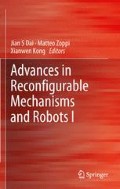Abstract
This paper relates two problems: enumeration of metamorphic robots in mechanical engineering and enumeration of polyforms in mathematics. First, a review of the two problems is presented. Some particularities of the enumeration of metamorphic robots and theoretical results about the enumeration of polyforms are described in order to create a bridge between these problems. Then, based on the results and the complexity of the enumeration of polyforms, some directions for further works on the planar enumeration of metamorphic robots are proposed.
Access this chapter
Tax calculation will be finalised at checkout
Purchases are for personal use only
References
Chirikjian G (1994) Kinematics of a metamorphic robotic system. In: IEEE international conference on robotics and automation, pp 449–455
Chirikjian G, Pamecha A (1996) Bounds for self-reconfiguration of metamorphic robots. In: IEEE international conference on robotics and automation, vol. 2, pp 1452–1457
Pamecha A, Chiang C, Stein D, Chirikjian G (1996) Design and implementation of metamorphic robots. In: ASME design engineering technical conference and computers in engineering conference, pp 1–10
Dumitrescu A, Suzuki I, Yamashita M (2002) High speed formations of reconfigurable modular robotic systems. In: IEEE international conference on robotics and automation, vol 1, pp 123–128
Chiang C, Chirikjian G (2001) Modular robot motion planning using similarity metrics. Auton Robot 10(1):91–106
Abrams A, Ghrist R (2004) State complexes for metamorphic robots. Int J Robot Res 23(7):811–830
Walter J, Welch J, Amato N (2004) Distributed reconfiguration of metamorphic robot chains. Distrib Comput 17(2):171–189
Walter J, Welch J, Amato N (2002) Concurrent metamorphosis of hexagonal robot chains into simple connected configurations. IEEE Trans Robot Autom 18(6):945–956
Rus D, Vona M (2001) Crystalline robots: self-reconfiguration with compressible unit modules. Auton Robot 10(1):107–124
Yoshida E, Murata S, Kurokawa H, Tomita K, Kokaji S (1998) A distributed reconfiguration method for 3D homogeneous structure. In: IEEE/RSJ international conference on intelligent robots and systems, vol 2, pp 852–859
Yim M, Lamping J, Mao E, Chase J (1997) Rhombic dodecahedron shape for self-assembling robots. Xerox PARC, SPL TechReport P9710777
Yim M, Zhang Y, Lamping J, Mao E (2001) Distributed control for 3D metamorphosis. Auton Robot 10(1):41–56
Chen I, Burdick J (1998) Enumerating the non-isomorphic assembly configurations of modular robotic systems. Int J Robot Res 17(7):702–719
Chitta S, Ostrowski J (2006) Enumeration and motion planning for modular mobile robots. Department of Computer and Information Science, University of Pennsylvania, Technical report no. MS-CIS-01-08
Martins D, Simoni R (2009) Enumeration of planar metamorphic robots configurations. In: ASME/IFToMM international conference on ReMAR2009, pp 610–618
Redelmeier D (1981) Counting polyominoes: yet another attack. Discrete Math 36(3):191–203
I. Jensen (2003) Counting polyominoes: a parallel implementation for cluster computing. In: Computational science—ICCS 2003, pp 698–698
Klarxer D (1967) Cell growth problems. Can J Math 19(4):851
Del Lungo A, Frosini A, Rinaldi S (2003) Eco method and the exhaustive generation of convex polyominoes. In: DMTCS, Springer, pp 129–140
Feretic S (2009) Polyominoes with nearly convex columns: a semidirected model. Arxiv preprint arXiv:0910.4573
Fukuda H, Mutoh N, Nakamura G, Schattschneider D (2008) Enumeration of polyominoes, polyiamonds and polyhexes for isohedral tilings with rotational symmetry. Lect Notes Comput Sci 4535:68–78
Barequet G, Moffie M, Ribó A, Rote G (2005) Counting polyominoes on twisted cylinders. In: Felsner S (ed) EuroComb2005. Discrete mathematics and theoretical computer science proceedings AE, Citeseer
Klarner D, Rivest R (1973) A procedure for improving the upper bound for the number of n-ominoes. Can J Math 25(3), 585–602
Jensen I, Guttmann A (2000) Statistics of lattice animals (polyominoes) and polygons. J Phys A Math Gen 33:L257
Voge M, Guttmann A (2003) On the number of hexagonal polyominoes. Theor Comput Sci 307(2):433–453
Lunnon W (1971) Counting polyominoes. In: Atkin AOL, Birch BJ (eds) Computers in number theory, Academic Press, London, pp 347–372
Caporossi G, Hansen P (1998) Enumeration of polyhex hydrocarbons to h = 21. J Chem Inf Comp Sci 38(4):610–619
Müller W, Szymanski K, Knop J, Nikolić S, Trinajstić N (1990) On the enumeration and generation of polyhex hydrocarbons. J Comput Chem 11(2):223–235
Yim M (1994) Locomotion with a unit-modular reconfigurable robot. PhD dissertation, Stanford University
Kerber A, Laue R, Meringer M, Rücker C (2004) Molecules in silico: the generation of structural formulae and its applications. J Comput Chem Jpn 3(3):85–96
Acknowledgments
This work was partially supported by two Brazilian Government Agencies: CNPq and CAPES.
Author information
Authors and Affiliations
Corresponding author
Editor information
Editors and Affiliations
Rights and permissions
Copyright information
© 2012 Springer-Verlag London
About this paper
Cite this paper
Salvi, A.Z., Simoni, R., Martins, D. (2012). Enumeration Problems: A Bridge Between Planar Metamorphic Robots in Engineering and Polyforms in Mathematics. In: Dai, J., Zoppi, M., Kong, X. (eds) Advances in Reconfigurable Mechanisms and Robots I. Springer, London. https://doi.org/10.1007/978-1-4471-4141-9_3
Download citation
DOI: https://doi.org/10.1007/978-1-4471-4141-9_3
Published:
Publisher Name: Springer, London
Print ISBN: 978-1-4471-4140-2
Online ISBN: 978-1-4471-4141-9
eBook Packages: EngineeringEngineering (R0)

